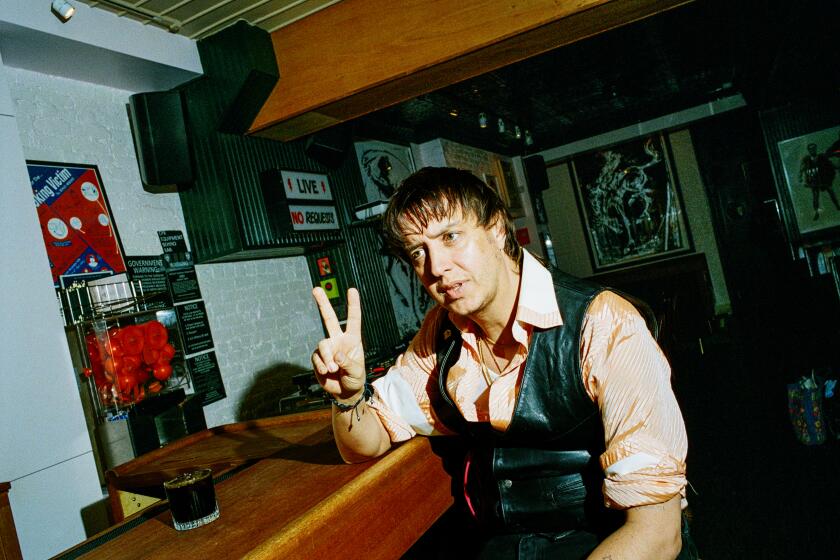Rock museum hails the sound of Clash
CLEVELAND — Armed with guitars, amps and attitude, they rocked the casbah, fought the law and hijacked a train in vain.
The Clash was more than a four-piece band. It was a rock ‘n’ roll revolutionary.
And now, 30 years after it first stormed across England and later invaded the United States with its sonic blend of rock, reggae, rap and righteousness, the Clash is being celebrated with an exhibit at the Rock and Roll Hall of Fame and Museum.
It’s enough to give Mick Jones a case of anxiety.
“I’ve got mixed trepidation about seeing it, getting to the museum stage of life and still being alive,” said Jones, who along with the late Joe Strummer, Topper Headon and Paul Simonon formed the Clash’s classic lineup.
“Revolution Rock: The Story of the Clash” has opened to the public and will be on display until April 15. Among the exhibit’s pieces are instruments, including Simonon’s famous smashed bass from the cover of “London Calling” -- regarded as one of rock’s finest recordings. The exhibit also includes stage clothing, memorabilia and original manuscripts of songs such as “Know Your Rights” and “Clampdown.”
Along with the Sex Pistols, the Clash erupted from London’s fertile music scene in 1976 to ride the first wave of British punk. But while Johnny Rotten and the bad-boy Pistols vented their nihilistic rage about political injustice with straightforward rock, the Clash’s sound was a mesh of influences.
Bob Marley, Mott the Hoople, the Who, Eddie Cochran and others could be heard in the Clash’s wide-ranging body of work.
“We just played the stuff we liked,” Jones said this month.
Strummer was the prime source of the band’s left-wing platform. He and others in London’s punk scene would squat in abandoned buildings as a form of protest and formed a band called the 101ers, named after the address of one such residence.
“Joe was always political,” Jones said. “He came from that background, but the Clash were never really allied to any political party. We were just having a go, really.”
But the Clash’s members made it clear that they were making more than music beginning with their first single, “White Riot,” in 1977 and on tracks like “Career Opportunities,” “Tommy Gun” and “London’s Burning” as well as in a three-disc album, “Sandinista” -- titled in tribute to the Nicaraguan political movement.
The Clash often performed in military-style clothing and staunchly supported political groups like the Anti-Nazi League and Rock Against Racism.
And although they were an instant success in Britain, it wasn’t until 1982’s “Combat Rock,” with its hits “Rock the Casbah” and “Should I Stay or Should I Go,” that the band made a splash in the United States.
“The States are so big that it took a while for people to hear us,” Jones explained. “But when we first came over in ‘78, everywhere we went we saw pockets of the punk scene flowering up.”
Jones, who was kicked out of the Clash in 1983 after a dispute over the band’s direction, went on to success with Big Audio Dynamite and is still making music. Now 51, he has few regrets about his time with a band considered among rock’s most influential groups.
“I would have liked to have done more stuff,” Jones said. “We never stopped learning, and even at the end we were doing great things. I would have liked to have done more.”
Jones said he misses Strummer, who died in 2002, “terribly. I think of him a lot.” Strummer’s death came a few months before the band was inducted into the Rock Hall in 2003 -- three years before the Sex Pistols.
Although the Clash’s surviving members attended their induction ceremony, the Pistols turned down their honor in a profane letter that was read during the hall’s enshrinement gala this year in New York.
“That’s not the way we would have handled it,” said Jones, who had pushed for the Pistols’ overdue induction. “We were proud to get in. It’s a little like getting into the Baseball Hall of Fame, isn’t it?”
More to Read
The biggest entertainment stories
Get our big stories about Hollywood, film, television, music, arts, culture and more right in your inbox as soon as they publish.
You may occasionally receive promotional content from the Los Angeles Times.









